Cathedral of Girona
In the north-east of Spain, in the autonomous community Catalonia, there is a city of Girona, the capital of the same-name province of Girona. The city of Girona is known for its history and its attractions. One of such attractions is the Cathedral of Girona.
The Cathedral’s construction began in 1312, and the first architects of the cathedral were brothers Henri and Jacques de Fauran (ou Faveran). The construction lasted for several decades, during which the builders’ plans and designs changed. In 1386 and 1416, even special commissions were called to determine the future direction of the cathedral’s construction. Two variants were discussed: the basilica with a central nave and two side naves, or a classical one-nave temple of the hall type. In 1417, the choice was made in favour of the second project, which was considered to be more refined.
The construction of the largest nave in the history of Gothic architecture – 34 meters high and 23 meters wide was entrusted to architect Guillaume Bofill. In general, Girona Cathedral is second in the world by the width of the nave after Saint Peter’s cathedral in Rome, the central nave’s width of which is 25 meters.
The construction of the cathedral was finished in 1604. Eventually, the cathedral incorporated different architectural styles: Romanesque, Gothic, Renaissance, and Baroque.
The cathedral’s bell tower is decorated by a weathercock with a bronze angel.
A huge stairway leads to the main (western) façade that consists of ninety steps. In the 17th century, when it was built, it was the largest staircase in Spain. The cathedral’s façade in Baroque style was mainly built in 1730 (the construction began in 1606). But until 1960, the façade was considered to be unfinished, and for the next two years local sculptors Josep M. Bohigas, Antoni Casamor, Jaume Busquets, and Domenec Fita set the sculptures in the empty niches. The façade is divided into three orders, in which seven statues are set. The upper part of the façade is topped by a large round window.
In the north section of the cathedral’s exterior there is a preserved Gothic portico of Saint Michael, in the south section – the portico of the Apostles of the 14th century, to which several sculptures were added in the 15th century.
The interior of the cathedral is a grandiose Gothic nave surmounted by diagonal cross vaults supported by a number of Gothic buttresses. In the choir there are rather simple (for this cathedral) seats of the 16th century. There has been preserved a Romanesque Bishop’s seat made of one piece of marble. Also in the choir there is a modern organ of 1943, which replaced the ancient organ of the 16th century designed by maestro J. Bordons. In the cathedral’s interior one’s attention is also captured by the stained glass windows; many of them were damaged in the 18th century, after which they were restored. Among them, especially two round rose windows stand out – the works of the first third of the 18th century by the famous Barcelona master Francesc Saladriga, who is believed to be one of the best masters in Baroque style.
In the cathedral there are the tombs of Count of Barcelona Ramon Berenguer II and his wife.
The cathedral’s cloister, located in the northern part of the church, is one of the most significant ones in Catalonia. This is a work of the 12th century of irregular shape with four unequal sides of Romanesque ambulatory, hiding the capitals.
Next to the CharlemagneTower there is a spout in the shape of a witch’s sculpture that is called by the local people “The Cry of a Witch.”
According to a legend, in the days of yore, a witch lived in Girona, who was against the temple’s construction and against the faith in God. And since her magic was helpless before faith and God’s providence, she avenged herself by throwing stones at the cathedral under construction. Unwilling to put up with the witch any longer, one day the supreme powers turned her into stone and placed her on one of the cathedral’s walls, so that no insults or curses would proceed out of her mouth, but only the pure rainwater.
In the temple’s reliquary many relics and precious things are kept. Among these things there are church utensils, items of silver and gold with embedded precious stones, statues, illustrated manuscripts of the Xth century, and the chief relic – the huge Tapestry of Creation, 3.65 meters by 4.7 meters, made by Catalonian weavers in the XI-XII centuries.
2 комментария
Leave a Comment
You must be logged in to post a comment.

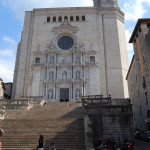

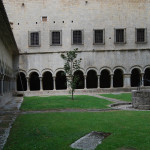
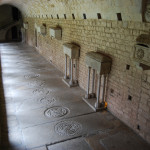
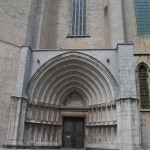
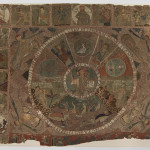
Евреи и построили Жирону,они жили там до того как вестготы завоевали Испанию. А кафедральный собор появился на несколько столетий позже.
Это внутренний дворик Кафедрального собора. Если лестница к Кафедральному собору это 17 век, то вот этот внутренний дворик 12 век! И как все неплохо сохранилось! Плиты, по которым ходят, это фамильные плиты знатных людей Жироны.